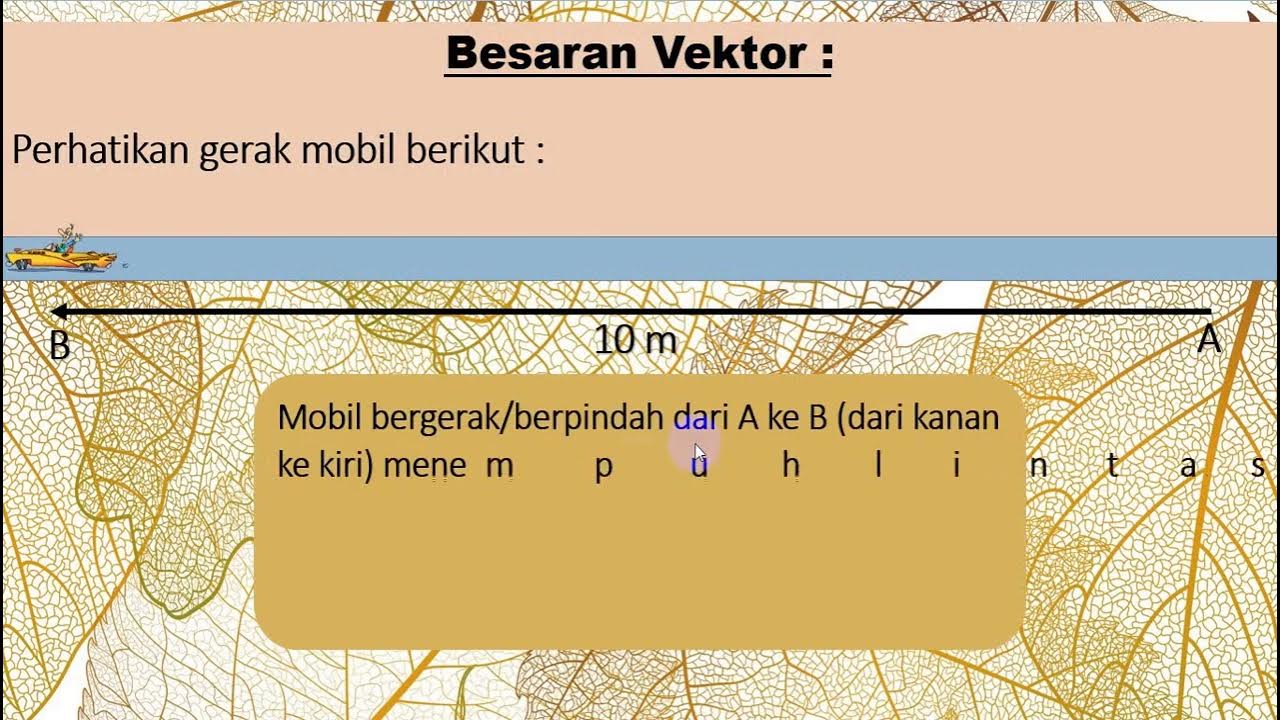Scalars and Vectors
Summary
TLDRThis video explains the key differences between scalar and vector quantities. A scalar quantity has only magnitude, such as distance, speed, mass, temperature, and volume, while a vector quantity has both magnitude and direction, such as displacement, velocity, force, and acceleration. The video discusses practical examples to illustrate these concepts, including the role of direction in determining whether a quantity is scalar or vector. It also covers how to graphically represent vectors, including calculating components using trigonometric functions and applying the Pythagorean theorem to solve for magnitudes.
Takeaways
- 📏 Scalar quantities have magnitude only, while vector quantities have both magnitude and direction.
- 🚗 Distance is a scalar quantity because it only describes magnitude without direction.
- 🔀 Displacement is a vector quantity because it includes both magnitude and direction.
- ⚡ Speed is a scalar quantity, whereas velocity is a vector as it includes direction.
- 💪 Force is a vector quantity because you can apply it in a specific direction (e.g., east, west, etc.).
- ⚖ Mass is a scalar quantity as it only has magnitude, not direction.
- 🌡 Temperature is also a scalar quantity since direction cannot be applied to it.
- 🏎 Acceleration is a vector quantity because it involves both magnitude and direction.
- 📦 Volume is a scalar quantity because direction cannot be applied to it.
- 📐 Vectors can be represented graphically, and their components can be described using trigonometric functions and Pythagoras' theorem.
Q & A
What is the difference between a scalar quantity and a vector quantity?
-A scalar quantity has only magnitude, whereas a vector quantity has both magnitude and direction.
How is distance classified, and why?
-Distance is a scalar quantity because it has only magnitude without a direction. For example, '5 miles' doesn't indicate in which direction the object is moving.
What is displacement, and how is it different from distance?
-Displacement is a vector quantity that includes both magnitude and direction. For example, '5 miles east' is a displacement because it specifies both the distance and the direction.
Is speed a scalar or vector quantity?
-Speed is a scalar quantity because it only describes how fast an object is moving without specifying a direction, like '30 miles per hour.'
What is the difference between speed and velocity?
-Speed is a scalar quantity with only magnitude, while velocity is a vector quantity that includes both speed and direction, such as '40 miles per hour north.'
Why is force considered a vector quantity?
-Force is a vector quantity because it has both magnitude and direction. For example, '50 newtons east' describes both the amount of force and the direction in which it is applied.
Can mass be classified as a scalar or vector quantity, and why?
-Mass is a scalar quantity because it only has magnitude and cannot be described with a direction. You can't apply direction to mass.
Is temperature a scalar or vector quantity, and why?
-Temperature is a scalar quantity because it only has magnitude, like '90 degrees Fahrenheit.' Direction cannot be applied to temperature.
Why is acceleration considered a vector quantity?
-Acceleration is a vector quantity because it describes how fast velocity is changing with respect to time, and it includes direction. For instance, you can accelerate towards the east or west.
Is volume a scalar or vector quantity?
-Volume is a scalar quantity because it only has magnitude. You cannot describe volume with direction, such as '50 liters of water east.'
Outlines

Cette section est réservée aux utilisateurs payants. Améliorez votre compte pour accéder à cette section.
Améliorer maintenantMindmap

Cette section est réservée aux utilisateurs payants. Améliorez votre compte pour accéder à cette section.
Améliorer maintenantKeywords

Cette section est réservée aux utilisateurs payants. Améliorez votre compte pour accéder à cette section.
Améliorer maintenantHighlights

Cette section est réservée aux utilisateurs payants. Améliorez votre compte pour accéder à cette section.
Améliorer maintenantTranscripts

Cette section est réservée aux utilisateurs payants. Améliorez votre compte pour accéder à cette section.
Améliorer maintenantVoir Plus de Vidéos Connexes

GRANDEZAS FÍSICAS (ESCALARES E VETORIAIS) | Resumo de Física Enem. |Prof Marcus Rossetto

Cinemática 04: Grandezas Vetoriais e Escalares

GCSE Physics Revision "Scalar and Vector Quantities"

Introdução ao Estudo da Física e Grandezas | Física - aula #1 | prof. Yuri Alves | Extensivo NPAC

Besaran vektor dan besaran skalar (Fisika SMA/MA Sagufindo kls X smt 1 : Vektor)

Vektor.
5.0 / 5 (0 votes)
